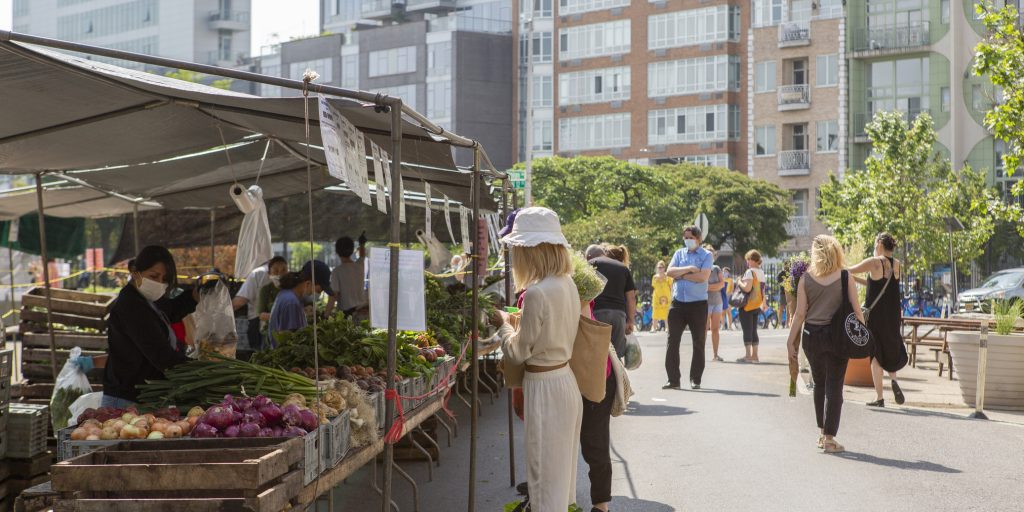Report: While remote work is causing offices to empty out, walkable cities are still in high demand
Given the reliance on vehicular transportation in the United States, some American cities historically haven’t prioritized being walkable in past planning and or design. But amid an unprecedented shift in the economy toward remote work, those that have are increasingly desirable for prospective residents. A new report from Smart Growth American and Places Platform, “Foot Traffic Ahead 2023,” found a higher demand for real estate in walkable urban spaces than in car-dependent suburban alternatives.
This implies that, while cities are evolving as offices clear out, their appeal hasn’t changed.
“As the market continues to choose walkable urbanism, it is critical for policymakers to protect existing affordability, promote new affordable housing, and remove barriers to increasing the supply of housing overall. All people deserve access to the quality-of-life and economic benefits that walkable urbanism can provide,” said Calvin Gladney, president and CEO of Smart Growth America about the report, which ranks the top 35 American metros by urban walkability. The findings show “that people want to live in walkable urban places, but there’s often not enough housing where folks need it, making it unaffordable and inaccessible to low- and moderate-income people, and to many communities of color.”
The report, which was co-authored by Michael Rodriguez and Christopher Leinberger, uses data from Yardi Matrix and Rocktop Partners. Each metro was ranked on its percentage of real estate inventory, square footage, and walkable urban development status using data about office space, multi-family rentals, and for sale properties.
On average, researchers identified 1.2% of the largest 35 metropolitan areas as walkable. Meanwhile, it houses 6.8% of the U.S. total population and drives 19.1% of the nation’s GDP.
“This is notable as it is illegal to build walkable urban densities and mixed-use development on much of the 98.8% of land that is car-dependent due to restrictive zoning policies in most metropolitan areas,” the report continues. “Tools to address high prices and short supply include zoning reform to increase walkable urban land supply and expansion and investment in affordable housing.”
Within metropolitan areas, identifiable lines separate walkable (urban) from drivable (suburban) areas. This distinction, which rose in popularity around the mid-20th century, has accounted for a huge amount of economic growth. It has also “created significant levels of racial and class segregation, compounding lack of wealth-building opportunities and inequalities that endure to this day,” the report says.
That trend began to shift in the mid-1990s, beginning with redevelopment of downtown spaces and sparked by public policy initiatives. And today, “there has been renewed market demand for walkable urbanism—a return to the urban forms that were predominant prior to 20th century drivable sub-urban expansion,” the report says.
Of all cities ranked in the report, Boston led with the most walkable urban housing at 24%, given its large percentage of pre-World War II homes. New York City’s metropolitan area led in office space, with 73% of all offices in the region located in walkable urban places. This poses an economic concern for city administrators as offices empty out. But while the rise in remote work is rapidly changing commercial real estate (about 42% of offices in the metros analyzed were in walkable areas), the report predicts that cities will return to “walkable urban roots” in the coming decades, “through the addition of small scale retail and other commercial back into these neighborhoods, which is followed by households investing substantial sums in rehabilitation of these houses.”
Despite the hardships of the pandemic, the report found that walkable urban spaces continue to grow, suggesting “these are areas to focus on rather than the declining 20th-century office parks and strip malls; and that even the declining areas can be revitalized with investment that reorients an area to walkability,” the report says.
“The so-called ‘death of the city’ has been overstated, again, as walkable urban price premiums and increased market share of office, retail, multi-family rentals and for-sale housing real estate in walkable urban places held up, despite impacts from the pandemic,” said Christopher B. Leinberger, managing director and co-founder of Places Platform. “These findings provide a strong economic base and cement walkable urban places and development as the wave of the future as we move toward a more connected, environmentally-sustainable way of life.”
The top 10 walkable cities ranked in the report can be found in the gallery above. A complete list of all 35 cities can be found in the 2023 Foot Traffic Ahead report on Smart Growth America’s website.



















